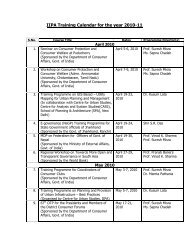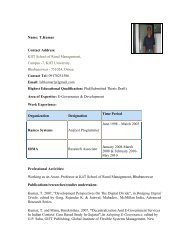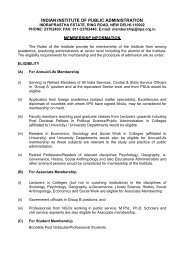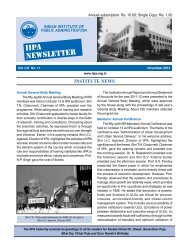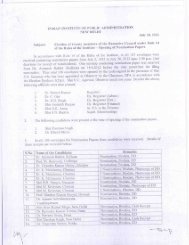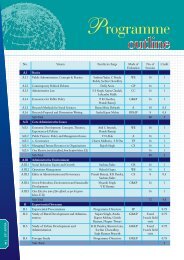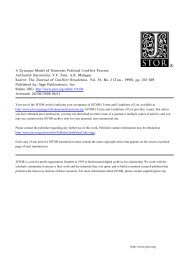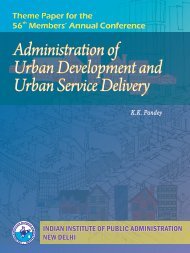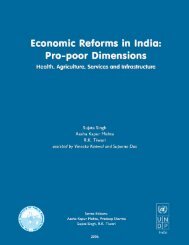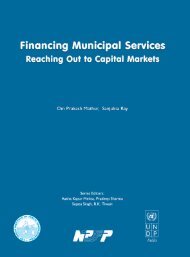Subcontracting and Economic - Indian Institute of Public Administration
Subcontracting and Economic - Indian Institute of Public Administration
Subcontracting and Economic - Indian Institute of Public Administration
You also want an ePaper? Increase the reach of your titles
YUMPU automatically turns print PDFs into web optimized ePapers that Google loves.
<strong>Subcontracting</strong> And <strong>Economic</strong> Reforms In India With Special Reference To Agro-based Industries In India<br />
7<br />
A Theoretical Model <strong>of</strong><br />
<strong>Subcontracting</strong> for High Quality<br />
The following is a model applicable to a new processed<br />
food introduced under monopoly. Although some modifications<br />
are needed to fit it in the monopolistic competition<br />
models, which may be prevalent for some food<br />
products, the essence <strong>of</strong> the story does not change.<br />
Chatterjee <strong>and</strong> Raychaudhuri (2000) originally proposed<br />
this type <strong>of</strong> a model.<br />
The Model<br />
In this model we try to find whether it is possible for the<br />
parent monopoly large firm to maintain the quality level<br />
<strong>of</strong> the final product in the industry with subcontracting.<br />
We assume that a monopolist is bringing a new product<br />
into the market <strong>and</strong> that the product is a non-durable<br />
processed food commodity. The production process is<br />
subdivided into two stages. <strong>Subcontracting</strong> small firms<br />
undertake the first stage <strong>of</strong> the production process. In<br />
the second stage, the monopolist finishes the product<br />
<strong>and</strong> supplies it to the market.<br />
It is assumed that quality level <strong>of</strong> the final product is<br />
determined by the quality <strong>of</strong> the unfinished product<br />
supplied by the subcontractors to the monopolist. The<br />
monopolist only finishes the product <strong>and</strong> supplies it to<br />
the market. The contractor can supply a high or low<br />
quality product.<br />
In this paper, we assume that the monopolist has no<br />
information about the product quality served by the sub-<br />
contractors, thus the quality level <strong>of</strong> the final product is<br />
also unknown to him. In this case we consider that there<br />
are two periods. The consumers can infer about the quality<br />
<strong>of</strong> the product at the end <strong>of</strong> the first period. In the<br />
second period, the product quality is common knowledge.<br />
The product becomes obsolete at the end <strong>of</strong> the<br />
second period. We assume that in the first period, consumers<br />
form an expectation about the quality <strong>of</strong> the product<br />
supplied by the monopolist <strong>and</strong> this expectation is<br />
formed exogenously (Metrick <strong>and</strong> Zeckhauser, 1996).<br />
Given these assumptions, we try to find the incentives<br />
scheme, which will induce the agent firms to produce a<br />
high quality product, whereby the monopolist can continue<br />
to exist in the market in the second period.<br />
We assume that a monopolist is facing a continuum <strong>of</strong><br />
consumers with the index <strong>of</strong> willingness to pay defined<br />
by the variable θ, where θ is distributed uniformly over<br />
the range [ θ, θ]<br />
with unit density. We define ‘q’ as the quality<br />
level <strong>of</strong> the final product, where ‘q’ can assume two different<br />
values q h<br />
<strong>and</strong> q l<br />
where q h<br />
> q l<br />
. It is assumed that a<br />
representative consumer considers that the quality <strong>of</strong> the<br />
product is high with probability µ. This probability is independent<br />
<strong>of</strong> firm’s pricing decision that is, µ is exogenously<br />
given. In the first period the consumer expects that a firm<br />
will supply quality level ‘ ’ where<br />
q = µq h<br />
+(1-µ) q l<br />
q h<br />
>q l<br />
-------------------------- 1<br />
It is assumed that consumers will infer about the quality<br />
14




